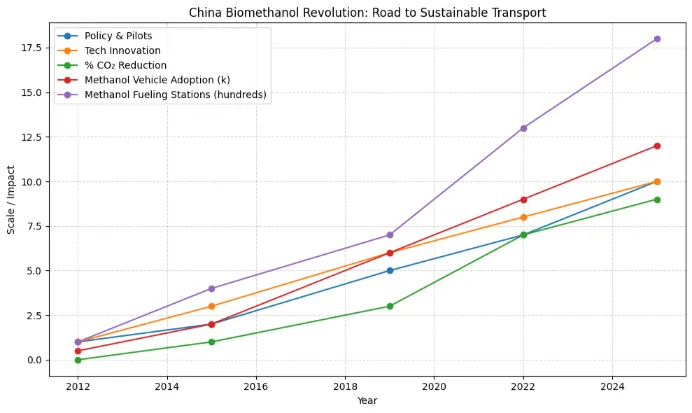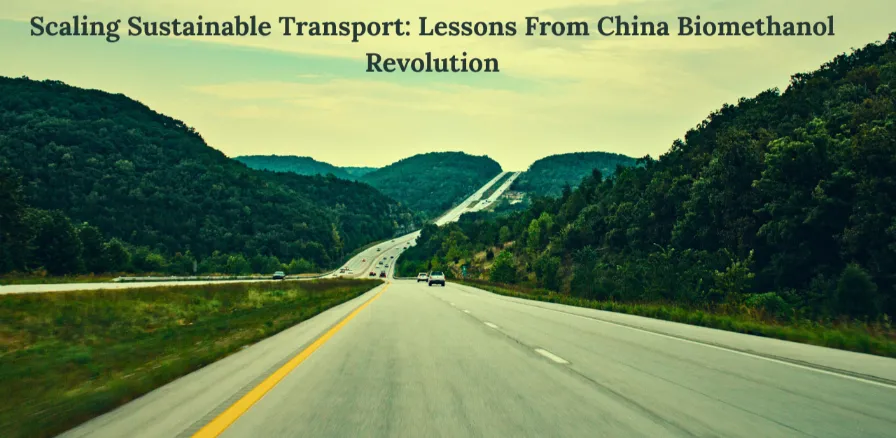Scaling Sustainable Transport: Lessons From China’s Biomethanol Revolution
The global push to decarbonize transport is urgent due to climate change and urban air pollution. While electric vehicles (EVs) gain attention, China’s biomethanol revolution offers a powerful, complementary approach to sustainable transport, especially for heavy-duty and maritime sectors. This blog breaks down China’s success in scaling biomethanol as a clean, renewable fuel and what the world can learn from it.
The Urgency of Sustainable Transport in China
China leads in methanol vehicle deployment, with over 30,000 vehicles and nearly 10 billion kilometers traveled. Biomethanol vehicles outperform coal- and CO₂-to-methanol vehicles in environmental and economic terms. For shipping, methanol is favored for retrofits and new builds due to its compatibility with dual-fuel engines and ease of storage. Single-fuel methanol engine technologies are advancing, with spark-ignition and pre-chamber systems showing promise for efficiency and emissions (Pu et al., 2024).
China, the world’s largest energy consumer, faces two main challenges in transport:
- Decarbonizing transport emissions to meet climate goals.
- Reducing reliance on imported oil for energy security.
China historically used coal-to-methanol (CTM) but shifted toward biomethanol (from agricultural and waste biomass) and e-methanol (from captured CO₂ and green hydrogen) to align with Carbon Peak (2030) and Carbon Neutrality (2060) targets. EVs can’t meet all transport needs alone, especially for commercial fleets, making biomethanol vital.
Why Biomethanol Is a Game Changer for Clean Mobility
Methanol (CH₃OH) is a clean-burning, high-octane alcohol fuel. Biomethanol is renewable, produced from biomass, with near-zero net carbon emissions. Key benefits driving China’s adoption include:
- Abundant feedstocks: Agricultural residues and waste provide sustainable local fuel sources.
- Mature technology: Production and engine adaptation are proven and scalable.
- Engine compatibility: Methanol fuels work in adapted internal combustion engines (M15, M85 blends, or M100 neat fuel).
- Cleaner emissions: Methanol combustion reduces particulate matter, SOx, and NOx compared to diesel and gasoline.
Biomethanol offers significant CO₂ emission reductions—up to 59% compared to coal-derived methanol and 54% per km versus conventional diesel in marine applications. While the life cycle cost of biomethanol is about 24% higher than coal-to-methanol, it can save 14.8% per km in marine operations compared to diesel, making it economically attractive in the long run. In shipping, biomethanol can cut lifecycle GHG emissions by 37%, with operational costs rising by 8–25% (De B. P. Viana et al., 2025).
Effective Policy Driving Biomethanol Growth
China’s government created clear policies to foster methanol fuel adoption:
- Pilot programs (2012): Multi-city trials tested M100 fuels in taxis, buses, and trucks, proving safety and efficiency.
- National promotion (2019): Multi-agency policy signaled long-term commitment to methanol vehicles.
- Focus on heavy-duty fleets: Targeted commercial fleets to maximize pollution and fuel impact.
- Standardization: National fuel and vehicle standards ensured safety and consistency.
Key Technological Innovations
Transitioning methanol from lab to road required solving technical challenges:
- Dedicated methanol engines: Companies like Geely created optimized M100 engines with better power and efficiency.
- Corrosion resistance: Specialized fuel system components were developed to handle methanol’s corrosive nature.
- Cold start technology: Advanced methods ensured engine performance in cold climates.
- Green methanol production: Scaling biomethanol from biomass and e-methanol from captured CO₂ plus renewable hydrogen.
Building Biomethanol Transport Infrastructure
China overcame the “chicken-and-egg” problem by:
- Deploying targeted fueling stations along commercial routes and pilot regions.
- Leveraging existing liquid fuel infrastructure for cost-efficient storage and distribution.
- Creating circular economy synergy between agriculture, chemical, and transport sectors.
Environmental and Economic Benefits
The success of biomethanol scaling shows measurable impacts:
- Carbon reduction: Biomass-based methanol cuts CO₂ emissions by over 59% vs. coal methanol.
- Air quality: Lower PM, NOx, and SOx emissions improve urban health.
- Energy security: Domestic biomass feedstock reduces crude oil dependency and price risks.
- Economic growth: Innovation and jobs grow with methanol vehicle production.
- Decarbonizing hard-to-abate sectors: Biomethanol fuels trucks and ships where batteries struggle.
Challenges and Solutions
China’s experience highlights key hurdles:
- Ensuring sustainable biomass feedstocks to avoid deforestation or food conflicts.
- Transitioning fully away from coal methanol to biogenic and e-fuel pathways for true carbon neutrality.
- Gaining public acceptance through testing, safety standards, and trusted commercial fleet adoption.
Future of Biomethanol in China’s Transport
Looking ahead, China emphasizes:
- E-methanol from renewable hydrogen and captured CO₂ as a carbon-neutral fuel cycle.
- Expanding biomethanol use for heavy-duty trucks, marine shipping, and even as a pathway for Sustainable Aviation Fuel (SAF).

What the World Can Learn From China’s Biomethanol Revolution
Five critical lessons emerge for global sustainable transport:
- Don’t rely solely on EVs; combine EVs, hydrogen, and biomethanol.
- Government-driven policy certainty is vital for scaling investment.
- Prioritize early adoption in commercial fleets like taxis and trucks.
- Leverage abundant domestic biomass and CO₂ for energy security.
- Keep innovating waste-to-fuel and e-fuel technologies for full lifecycle sustainability.
China’s biomethanol revolution proves that sustainable liquid fuels are essential for large-scale decarbonization. Its strategic approach is a scalable, pragmatic roadmap for countries seeking clean, secure, and economically sound transport solutions worldwide.
Citations
De B. P. Viana, L., Wei, H., Szklo, A., Rochedo, P., & Müller-Casseres, E. (2025). Paving the Way for Low‐Carbon Shipping Fuels in Long‐Haul Trade Routes. International Journal of Energy Research. https://doi.org/10.1155/er/8835499.
Pu, Y., Dejaegere, Q., Svensson, M., & Verhelst, S. (2024). Renewable Methanol as a Fuel for Heavy-Duty Engines: A Review of Technologies Enabling Single-Fuel Solutions. Energies. https://doi.org/10.3390/en17071719.
From Field Waste to Fuel: China’s Rice Straw Biomethanol Revolution – Energy Efficiency, Economic Analysis, and Environmental Benefits
